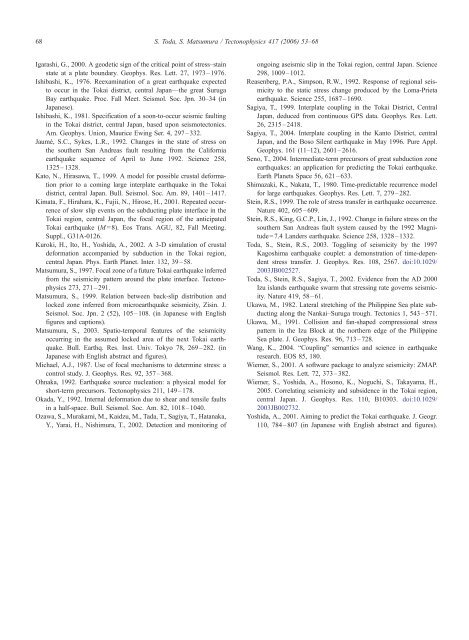Printable article - Evidence from the AD 2000 Izu Islands swarm that ...
Printable article - Evidence from the AD 2000 Izu Islands swarm that ...
Printable article - Evidence from the AD 2000 Izu Islands swarm that ...
- No tags were found...
Create successful ePaper yourself
Turn your PDF publications into a flip-book with our unique Google optimized e-Paper software.
68S. Toda, S. Matsumura / Tectonophysics 417 (2006) 53–68Igarashi, G., <strong>2000</strong>. A geodetic sign of <strong>the</strong> critical point of stress–stainstate at a plate boundary. Geophys. Res. Lett. 27, 1973–1976.Ishibashi, K., 1976. Reexamination of a great earthquake expectedto occur in <strong>the</strong> Tokai district, central Japan—<strong>the</strong> great SurugaBay earthquake. Proc. Fall Meet. Seismol. Soc. Jpn. 30–34 (inJapanese).Ishibashi, K., 1981. Specification of a soon-to-occur seismic faultingin <strong>the</strong> Tokai district, central Japan, based upon seismotectonics.Am. Geophys. Union, Maurice Ewing Ser. 4, 297–332.Jaumé, S.C., Sykes, L.R., 1992. Changes in <strong>the</strong> state of stress on<strong>the</strong> sou<strong>the</strong>rn San Andreas fault resulting <strong>from</strong> <strong>the</strong> Californiaearthquake sequence of April to June 1992. Science 258,1325–1328.Kato, N., Hirasawa, T., 1999. A model for possible crustal deformationprior to a coming large interplate earthquake in <strong>the</strong> Tokaidistrict, central Japan. Bull. Seismol. Soc. Am. 89, 1401–1417.Kimata, F., Hirahara, K., Fujii, N., Hirose, H., 2001. Repeated occurrenceof slow slip events on <strong>the</strong> subducting plate interface in <strong>the</strong>Tokai region, central Japan, <strong>the</strong> focal region of <strong>the</strong> anticipatedTokai earthquake (M =8). Eos Trans. AGU, 82, Fall Meeting.Suppl., G31A-0126.Kuroki, H., Ito, H., Yoshida, A., 2002. A 3-D simulation of crustaldeformation accompanied by subduction in <strong>the</strong> Tokai region,central Japan. Phys. Earth Planet. Inter. 132, 39–58.Matsumura, S., 1997. Focal zone of a future Tokai earthquake inferred<strong>from</strong> <strong>the</strong> seismicity pattern around <strong>the</strong> plate interface. Tectonophysics273, 271–291.Matsumura, S., 1999. Relation between back-slip distribution andlocked zone inferred <strong>from</strong> microearthquake seismicity, Zisin. J.Seismol. Soc. Jpn. 2 (52), 105–108. (in Japanese with Englishfigures and captions).Matsumura, S., 2003. Spatio-temporal features of <strong>the</strong> seismicityoccurring in <strong>the</strong> assumed locked area of <strong>the</strong> next Tokai earthquake.Bull. Earthq. Res. Inst. Univ. Tokyo 78, 269–282. (inJapanese with English abstract and figures).Michael, A.J., 1987. Use of focal mechanisms to determine stress: acontrol study. J. Geophys. Res. 92, 357–368.Ohnaka, 1992. Earthquake source nucleation: a physical model forshort-term precursors. Tectonophysics 211, 149–178.Okada, Y., 1992. Internal deformation due to shear and tensile faultsin a half-space. Bull. Seismol. Soc. Am. 82, 1018–1040.Ozawa, S., Murakami, M., Kaidzu, M., Tada, T., Sagiya, T., Hatanaka,Y., Yarai, H., Nishimura, T., 2002. Detection and monitoring ofongoing aseismic slip in <strong>the</strong> Tokai region, central Japan. Science298, 1009–1012.Reasenberg, P.A., Simpson, R.W., 1992. Response of regional seismicityto <strong>the</strong> static stress change produced by <strong>the</strong> Loma-Prietaearthquake. Science 255, 1687–1690.Sagiya, T., 1999. Interplate coupling in <strong>the</strong> Tokai District, CentralJapan, deduced <strong>from</strong> continuous GPS data. Geophys. Res. Lett.26, 2315–2418.Sagiya, T., 2004. Interplate coupling in <strong>the</strong> Kanto District, centralJapan, and <strong>the</strong> Boso Silent earthquake in May 1996. Pure Appl.Geophys. 161 (11–12), 2601–2616.Seno, T., 2004. Intermediate-term precursors of great subduction zoneearthquakes: an application for predicting <strong>the</strong> Tokai earthquake.Earth Planets Space 56, 621–633.Shimazaki, K., Nakata, T., 1980. Time-predictable recurrence modelfor large earthquakes. Geophys. Res. Lett. 7, 279–282.Stein, R.S., 1999. The role of stress transfer in earthquake occurrence.Nature 402, 605–609.Stein, R.S., King, G.C.P., Lin, J., 1992. Change in failure stress on <strong>the</strong>sou<strong>the</strong>rn San Andreas fault system caused by <strong>the</strong> 1992 Magnitude=7.4Landers earthquake. Science 258, 1328–1332.Toda, S., Stein, R.S., 2003. Toggling of seismicity by <strong>the</strong> 1997Kagoshima earthquake couplet: a demonstration of time-dependentstress transfer. J. Geophys. Res. 108, 2567. doi:10.1029/2003JB002527.Toda, S., Stein, R.S., Sagiya, T., 2002. <strong>Evidence</strong> <strong>from</strong> <strong>the</strong> <strong>AD</strong> <strong>2000</strong><strong>Izu</strong> islands earthquake <strong>swarm</strong> <strong>that</strong> stressing rate governs seismicity.Nature 419, 58–61.Ukawa, M., 1982. Lateral stretching of <strong>the</strong> Philippine Sea plate subductingalong <strong>the</strong> Nankai–Suruga trough. Tectonics 1, 543–571.Ukawa, M., 1991. Collision and fan-shaped compressional stresspattern in <strong>the</strong> <strong>Izu</strong> Block at <strong>the</strong> nor<strong>the</strong>rn edge of <strong>the</strong> PhilippineSea plate. J. Geophys. Res. 96, 713–728.Wang, K., 2004. bCouplingQ semantics and science in earthquakeresearch. EOS 85, 180.Wiemer, S., 2001. A software package to analyze seismicity: ZMAP.Seismol. Res. Lett. 72, 373–382.Wiemer, S., Yoshida, A., Hosono, K., Noguchi, S., Takayama, H.,2005. Correlating seismicity and subsidence in <strong>the</strong> Tokai region,central Japan. J. Geophys. Res. 110, B10303. doi:10.1029/2003JB002732.Yoshida, A., 2001. Aiming to predict <strong>the</strong> Tokai earthquake. J. Geogr.110, 784–807 (in Japanese with English abstract and figures).






